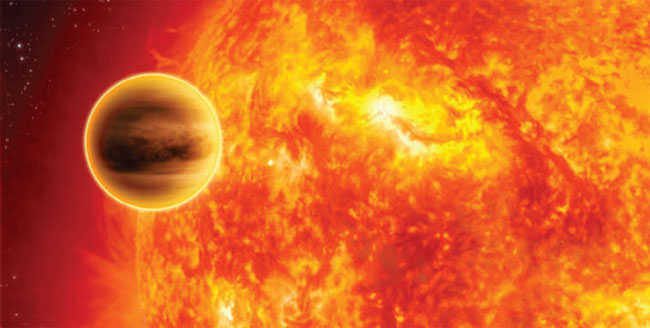Newfound Planet Might Be Near Death

A newly discovered planet that whips around its star in lessthan a day may have been found mere cosmic moments before its demise.
The planet, WASP-18b, is one of the "hotJupiter" class of planets that are huge in size (10 times the mass ofJupiter in this case), but orbit very close to their stars. Their veryexistence was surprising to astronomers when the first of them were found a fewyears back. Now they've become common discoveries.
But this scorched, gaseous world is only one of two knownexoplanets that orbits its star in less than one Earth day (0.94 days to beexact). Coupled with its hefty mass, this leads to strong gravitational tugsbetween the planet and its star, WASP-18. (WASP stands for the Wide AngleSearch for Planets, run by several universities in Britain.)
These gravitational interactions create tides thought tosqueeze and stretch the planet and even alter its orbit: If the planet orbitsfaster than the star spins, the planet should be pulled inward toward the star;if the star spins faster, the planet should be pushed outward (the latter isthe case with the moon's orbit around Earth; the moonis moving away from us as you read this).
Given what astrophysicists know about the dynamics involved,astronomers think WASP-18b is moving toward its host star, but that would makeobserving the planet a 1-in-1,000 shot: While planets spend most of their livessort of growing up, they perish in a cosmic blink of the eye. And so there isonly a small time window where a planet would be in this position of impendingdemise ? it would be statistically more likely to have found it much earlier inits lifetime, or after its destruction (which means it wouldn't have been seenat all).
"Either the odds of finding it are really small, and wejust got lucky," or there's something fundamental about the tidalinteractions between stars and their planets that astronomers are missing, saidDouglas Hamilton, an astronomer at the University of Maryland in College Park whowas not involved with the finding.
Knowledge of how tidal interactions work between stars and planetsis largely based on our own solar system, having to do with all the rotational (ortidal) energy that a system has when a cloud of gas and dust condenses to forma star, then leftover material flattens into a rotating disk where planetsform. Estimates of the rate at which a star dissipates all that tidal energycould be off-base, however. If the star isn't very good at dissipating thisenergy, the planet will survive a lot longer before spiraling into its hoststar.
Get the Space.com Newsletter
Breaking space news, the latest updates on rocket launches, skywatching events and more!
Or there could be "more exotic possibilities," Hamilton told SPACE.com, such as some force holding the planet up against the inward dragof the tidal forces. Hamilton described the possibilities in an opinion essayin the Aug. 27 issue of the journal Nature, where the discovery of the planetis also detailed.
Astronomers will be able to test which scenario (a planetnear its death or some funky physics) is more likely ? they just have to wait afew years. If the planet is, in fact, spiraling in toward its star, the demisemight not occur for thousands or millions of years, but there should benoticeable changes in its orbital period in about a decade. Astronomers justhave to keep their eye on the system.
"We just gotta wait and be patient," Hamilton said. Whatever the answer turns out to be, "this one is going to teach ussomething," he said.
- Video ? NASA's Kepler: Hunting Alien Earths
- Top 10 Most Intriguing Extrasolar Planets
- Newfound Planet Orbits Backward
Join our Space Forums to keep talking space on the latest missions, night sky and more! And if you have a news tip, correction or comment, let us know at: community@space.com.

Andrea Thompson is an associate editor at Scientific American, where she covers sustainability, energy and the environment. Prior to that, she was a senior writer covering climate science at Climate Central and a reporter and editor at Live Science, where she primarily covered Earth science and the environment. She holds a graduate degree in science health and environmental reporting from New York University, as well as a bachelor of science and and masters of science in atmospheric chemistry from the Georgia Institute of Technology.









